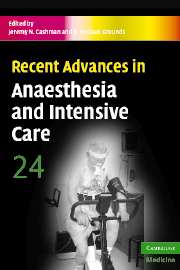Book contents
- Frontmatter
- Contents
- List of contributors
- Preface
- 1 The role of cardiopulmonary exercise testing in preoperative evaluation of surgical patients
- 2 Oesophagectomy for cancer
- 3 Vascular surgery
- 4 Anaesthesia for the elderly
- 5 Deaths following anaesthesia: lessons from NCEPOD
- 6 Pelvic and acetabular trauma
- 7 Echocardiography
- 8 Levosimendan
- 9 Critical care outreach: 6 years on
- 10 Critical care and biological disasters: lessons learned from SARS and pandemic influenza planning
- 11 Evaluating clinical performance
- 12 Non-technical skills and anaesthesia
- 13 Simulators in anaesthetic training to enhance patient safety
- Index
- References
9 - Critical care outreach: 6 years on
Published online by Cambridge University Press: 15 December 2009
- Frontmatter
- Contents
- List of contributors
- Preface
- 1 The role of cardiopulmonary exercise testing in preoperative evaluation of surgical patients
- 2 Oesophagectomy for cancer
- 3 Vascular surgery
- 4 Anaesthesia for the elderly
- 5 Deaths following anaesthesia: lessons from NCEPOD
- 6 Pelvic and acetabular trauma
- 7 Echocardiography
- 8 Levosimendan
- 9 Critical care outreach: 6 years on
- 10 Critical care and biological disasters: lessons learned from SARS and pandemic influenza planning
- 11 Evaluating clinical performance
- 12 Non-technical skills and anaesthesia
- 13 Simulators in anaesthetic training to enhance patient safety
- Index
- References
Summary
It has been nearly six years since ‘Comprehensive Critical Care’ heralded the introduction of Critical Care Outreach services in England. Whilst still the source of much critical debate, Critical Care Outreach has been, and remains, a central feature of recent approaches to address capacity pressures, and the management of the ever increasing numbers of acutely unwell and critically ill patients in National Health Service (NHS) hospitals regardless of their location – the oft cited ‘Critical Care without Walls’ approach.
Context and background of critical care outreach
Critical and acute care provision in England has changed drastically over the last 20 years. Between 1982 and 1995 there was a 25% decrease in the number of acute hospital beds. At the same time the population has grown and demand increased. The provision of critical care is made more difficult in the UK by factors such as low levels of staffing compared to other developed countries, an ageing population, the availability of increasingly complex clinical procedures, the increasing number of patients requiring Level 1 care in general wards, increased public awareness and expectation, changes in nursing education and staffing, changes in medical education and work practices including the new consultant contract, European Working Time Directive and Modernising Medical Careers. This has led to an inadequate provision of critical care beds.
For many years clinical intuition, clinical experience and anecdotal evidence have suggested that care offered to patients in the period preceding transfer to the intensive care unit (ICU) is often inadequate.
- Type
- Chapter
- Information
- Recent Advances in Anaesthesia and Intensive Care , pp. 143 - 158Publisher: Cambridge University PressPrint publication year: 2007

